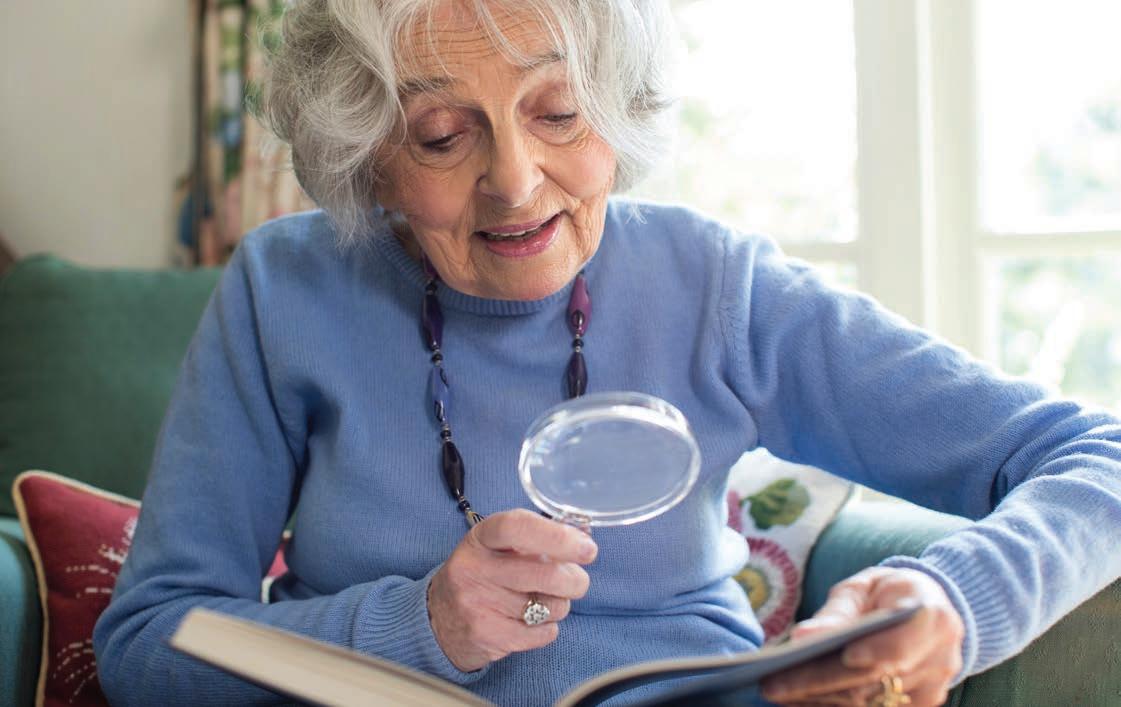
4 minute read
Living with low vision
LIVING with LOW VISION LOW VISION
Many people at some time in their life will experience a problem with their eyesight. If you start to notice your vision changing or you have any concerns about your eyesight, consult the Eye Centre PrimeCare.
Advertisement
What is low vision?
Low vision is sight loss, reduced vision or vision loss that cannot be corrected or improved by glasses, medicine or surgery and makes everyday tasks diffi cult.
If you have low vision, you may:
• have diffi culty reading and writing • have a loss of depth perception, making it diffi cult (for example) to identify if a step is high or low • have less contrast sensitivity, which makes it hard to see a curb, steps, a hole in the pavement or pale or coloured print • have problems seeing at distance, making it diffi cult to determine whether pedestrian crossing signals are on or off, or see street name signs • see spots that block your central vision, which make it hard to identify landmarks or notice obstacles • have a loss of visual field, which results in reduced peripheral vision; this makes it diffi cult to move around without bumping into things (such as coffee tables or open cupboard doors) • not be able to see and identify faces, which can make communication more difficult.
Some health conditions that may cause blindness do not have any symptoms early on, may only affect one eye and may not always be easily detectable except through an eye examination. Regular eye examinations are the best way to prevent a vision impairment. Have frequent eye examinations if you have a family history of eye disease or a medical condition such as diabetes or hypertension.
Managing your daily tasks
1) Make things brighter and bigger
• Lighting
If you have low vision, good lighting is really important. Direct light on a task improves contrast. For reading, writing or other detailed tasks, use direct lighting from an adjustable lamp positioned close by. Install extra lights over work surfaces.
• Use contrast
Strong contrasts can help you to see more easily. For example, pour coffee into white cups and put white plates on dark place mats. Have a dark chopping board and a light one. Chop dark items (eg, meat) on the light board and light items (eg, onion) on the dark board. Contrast can be tactile as well as visual. For example, you can use a rubber band to help you know the difference between similar containers, for example, shampoo and conditioner.
• Control glare
Wear sunglasses, or ones that fit over your glasses (fitovers) or clip-on sunglasses. A wide-brimmed hat or visor is another good way of controlling glare and light sensitivity.
Tinted glasses lens can help, particularly with glare from indoor lights.
• Enlarge
Sit closer to the television, and at the front at concerts, presentations and performances. Many smartphones, tablets, e-readers and computers have features that can increase text size and contrast. Some have a text-to-speech feature, allowing you to hear the text spoken rather than read it, and most have back lighting. Use a photocopier to enlarge timetables, recipes, address books, menus, etc.

Losing vision does not have to mean giving up your usual activities, but it can mean finding new ways of doing them.
2) Re-organise
• Eliminate hazards
Make sure your home is safe. Secure mats and trip hazards. Make sure everything has a place, so you can easily find it.
• Be organised
Thinking ahead and being organised can make a big difference. • Have designated spots for important items like your keys and wallet. • Keep work spaces clear. Have a place for everything, and put things back in their place. Close cupboard doors and make sure floors remain clear. • Organise your fridge and pantry consistently, grouping similar foods together. • Before you travel, get any forms you’ll need (eg, departure cards or visa applications) and fill them out at home. • Ask your pharmacy about prepackaging medication into blister packs with the right dose for the right time of the day. Also available are talking thermometers.
3) Going out
An important part of living with low vision is maintaining normal family/wha¯ nau, social, leisure and work activity. When you go out, plan, and think ahead and allow plenty of time. Be prepared by visualising the route you will take and anticipating where you might experience diffi culties.
Restaurants can send menus to you in advance, or you can look at them online before you go.
More information and tips can be found on the Ministry of Health website.
• Ophthalmic Eye Examinations • Cataract Extraction and lens ARE OUR FOCUS implant • Pterygium Excision plus conjunctive graft • Injection for wet age related Macular Degeneration • Glaucoma treatment • Cataract surgery
FOR ALL
DISEASES
OF THE EYE Help is only a phone call away 0800 11 0030


WE ALSO CONSULT IN KERIKERI



EYE CENTRE
PRIMECARE
Eye Specialists:
David Dalziel and Andrew Watts
Ph: 09-972 7022
12 Kensington Ave, Whangarei Fax: 09-972 7026 Email: pceyes@xtra.co.nz










